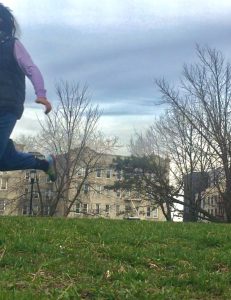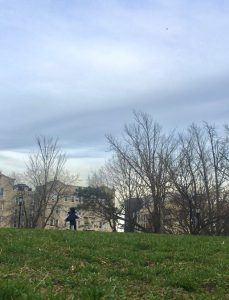Looping a refrain, following the ripple by Benedict Nguyen
May 8, 2020
Dancer, Writer, and Curator, Benedict Nguyen was part of the Danspace Project Voice & Body research group in 2019-2020.
I have this thing where I listen to the same song(s) on repeat for weeks, the same few albums for months at a time. Each track of an album is engraved in my memory both in the original sequence and as distinct units, shone in relief by the serendipity of hitting shuffle. I don’t tire from the delightful mocking self-importance she imbues in just one vowel, or the way the same rhythms make me shuffle my hips as I walk. It’s not even the familiarity of the same 1’s and 0’s beaming up my aux cord. It’s the way how even the predictable same can remind me how the now I’m living is new, how a repeat-song can unlock energy I didn’t know my body had, how it takes me past the mundanity of its (pop music) form and into a reverie that’s spontaneous but reliably there, nearly every time.
This kind of ode to music has been written before, and I’m okay to say it again, to play the same album on shuffled repeat, to stumble and search for the next hour of recorded music that I’ll loop into thousands of minutes of my life.
I’m curious about the particular affects of listening to songs on repeat, which can feel like an odd choice when there’s so much else to listen to. Most of my repeat-songs could be categorized as ‘popular music,’ usually songs with that verse-chorus-verse-chorus-bridge-chorus structure and steady beats. I’m not writing about any artist or song in particular so much as the looping of a song and its associated looping of behaviors and feelings.
When I’m feeling something intense, I’ll play the song that makes me feel like I’m screaming too. I don’t need to blast the volume or even lip sync, though I sometimes do. The exalted release brought by the song has already accumulated in past moments it’s been there for me. The repetition and escalation of a wail within the form itself allows me to chant my rage, my ecstasy, my grief and thrust its vibrancy outward. It’s not a meditation or a release but an expression bouncing between my ears that feels like it’s happening all over my body.
If I’m not belting, I’m probably dancing on the train, following the ripple through the balls of my feet, the ball and socket joints protecting my pelvis. Perhaps talking about how music shapes how I move or how I need music to help me move in a certain way could sound like subjugating movement to music. I have trouble with this defensive logic cited by movement artists who question the tyranny of 5-6-7-8. Maybe that’s predictable but isn’t it magic how music helps me move so much, how my pelvis drops just a little bit differently each time.
Grooving to a repeat-song reminds me how I came into calling my moving ‘dancing.’ Of course, one could always be called the other, but I sometimes call it ‘dance’ on purpose because ‘music’ reminds me to ‘dance’ even when I’m tired of it, when I can no longer fit into someone else’s choreography or the preciousness of Performance.
When I’m just moving for me, for the song that beckons me, I feel possibility. I can feel like more than a vessel of vital organs, more than a person, more than my narratives or even the song itself. I can feel like a feeling.
Because the looping is also not about the text, the refrain imbued with so much meaning, it almost loses meaning. In the first listens of a repeat-song, I usually only catch words accidentally, the contours of consonants more sound than text. Even as the words start to code in my brain, I can listen to a song for months before realizing a lyric I had been singing was saying something else the whole time.
Maybe it’s having someone else’s words channeled through me that helps me find my own. The aesthetics of these sounds tell me something about my taste and reaffirm it through repeat. The immediacy with which I can repeat, can soothe sonic cravings through a handheld machine, is wildly different from how people took in music even thirty years ago. The friction of swapping out scratched CDs, a relatively recent radical feat of portable choice, has been smoothed over even more by touch screens.
Access to such a screen allows one to choose an exact song to accompany an exact kind of moment. It is both contradictory and fitting that crafting a playlist from across an archive longer than a lifetime can feel like an exercise in single-tracking, a technocratic term telling us not just how to work productively, but how to think. Picking a song to repeat feels monumental and also a mundane fact of our technological moment. But listening to one song again and again is more than single-tracking. A play can traverse multiple dimensions of time passing through the space around me.
Witnessing performance usually involves some level of discomfort, of sitting in a chair too long, of paying attention when I’m tired. But I also get to appreciate the humanity of something grown from so many hours of work and rehearsal and study, none of it enough to give an audience the perfect splice of the best version of the thing itself. If you don’t want to have to include your voice breaking in a track, you can pick another take. In a room, you’re meant to see people moving their bodies now, here, for this occasion. I can sway to the beautiful wavers in an artist’s voice, the breathy feedback in a mic or even better, heavy breathing from a stage just feet away from me.
I don’t often feel compelled to revisit a work of movement-based performance. Repeat is not possible. Even if I were to watch a video of it, I fear that the video will supplant my first memory of being there—the light beams bouncing at angles picked up by my eyeballs alone, the smell of others filtered through a stuffy nose—something so singularly mine that no one else can play it back. Even when I show up alone, watching performance rarely feels like a solitary act. When I want music to gesture to the collective, I sometimes watch footage of musicians’ concerts, melding the sound of screaming fans over scratchy audio with YouTube comments.
The 2008 Universal Music fire destroyed thousands of musician’s recordings. The loss of these masters can remind us we’re just listening to deceptive facsimiles of original moments, 2-dimensional waves instead of a human singing to me. When I forget my headphones, I imagine a track playing in my head, singing softly to myself to make it more real. I can also imagine the silence that might await me if I chose to take a break from the constant stimulation of content saturation.
Singing in the shower, in the car I used to drive, in an empty enough street, I can pretend I’m professing something people came to see or even just that one person I want to hear it. I can pretend I’m being sung to alone. Behind my headphones, the right soundtrack can elevate the quotidian to high drama, though I don’t need a witness to feel good about it. The fantasy is the point; the affect flows as deep as I need it to. I care and I’m letting go at the same time. These small waves carve their own spaces within my interior self, ones that call my attention to I can’t translate into language.
When I have headphones on, people sometimes look at me like they want to say something but decide against it because I look even more closed off than usual. One could argue that streaming music in the company of other people is just another manifestation of anti-social tendencies, the worst of neoliberal individualism.
I think about playing one of my personal big hits for someone, only for it to not resonate. I think about having to hear a song that someone insists is incredible but to me, just sounds trite. That’s okay. There are other songs we can sing together.
On the dancefloor, the DJ selects a big popular hit to bring the masses together. At the pre-chorus, they’ll cut the volume so we can shout in the gaps. When they spin a new mix or a lesser known song, some people stand unsure of what to do with their bodies. Let’s keep dancing.
My repeat-songs used to all be slow-growers. I’d be indifferent to a song until I was addicted. Lately, I’ve been able to tell within 30 seconds of the first listen that I’ve found a new repeat-song. Maybe Spotify’s algorithms have mastered my brain. Maybe I’m searching more hungrily for that new song to hide between my ears, a new song that propels me to belt senseless words in a crowded street because truly no one cares what squealing a self-mocking vowel does for me.
A song can string together minutes between the too-loud bus and the roommate, helping me notice when I’m porous and when I can seal myself shut with some earbuds. A song can be a portal bringing the future closer, opening space for past memories to float present, steeping, stretching between the hook and the chorus, between the sound in my ear and my moving body, chasing feelings around endless loops.
—
This essay was written in conversation with the work of the Voice and Body Research Group for Platform 2020, Utterances from the Chorus. Members include Jasmine Hearn, Tendayi Kuumba, Benedict Nguyen, Samita Sinha, Tatyana Tenenbaum, and Asiya Wadud.


